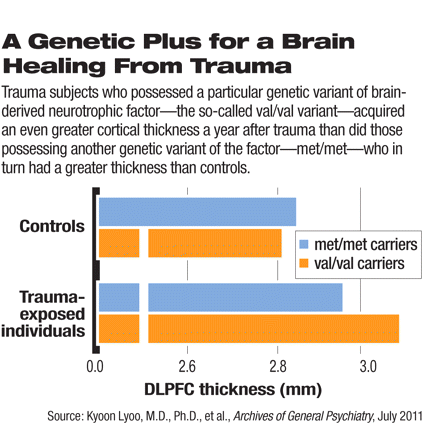The first longitudinal neuroimaging study of disaster survivors has produced an intriguing finding—as people heal from posttraumatic stress disorder (PTSD), their brains become thicker.
The study's lead investigator was Kyoon Lyoo, M.D., Ph.D., a professor of psychiatry at Seoul National University in South Korea. Results appeared in the July Archives of General Psychiatry.
The study included 30 survivors of a subway fire who met criteria for a DSM-IV PTSD diagnosis and 36 age- and gender-matched control subjects. (Six extra controls were enrolled in the event that there was an attrition in their number during the study.) During the next five years, the scientists not only tracked the mental health status of the PTSD subjects, but used neuroimaging to see what was going on inside their brains and those of the control subjects at various time points. The researchers then compared brain scan results for both groups.
The trauma subjects experienced a progressive reduction in PTSD symptoms during the five-year study. During the first year and a half of the study, the trauma subjects also acquired a thicker dorsolateral prefrontal cortex than controls did. After that, though, the thickness gradually normalized.
Lyoo and colleagues thus concluded that the extra cortical thickness that the trauma subjects acquired after their trauma helped them recover from their ordeal. This was the case because, as they explained in their report, "in nonhuman primates ... stress exposure helps develop resilience ... and increase the ... thickness of the prefrontal cortex."
The reasons why a greater dorsolateral prefrontal cortical thickness might undergird and promote psychological recovery are apparent, the researchers noted. For example, the role of this brain region "in controlling negative emotions has been well documented in healthy individuals," they wrote. "Emotion-regulating cognitive strategies, such as reappraisal of negative events and suppression of unpleasant memories, are [also] associated with an increased dorsolateral prefrontal cortex and decreased limbic activities."
The study also revealed another notable finding: individuals who experienced trauma and who possessed a particular genetic variant of brain-derived neurotrophic factor—the so-called val/val variant—acquired an even greater cortical thickness a year after trauma than did those possessing one of the two other genetic variants of the factor—val/met or met/met. This finding did not surprise the scientists since other researchers have found that individuals with the val/val variant of brain-derived neurotrophic factor recover more quickly from PTSD than do individuals with the val/met or met/met version.
The findings have implications for people who are commonly exposed to serious levels of trauma, such as firefighters or combat personnel, Lyoo and his group suggested. For example, if there were some way to bolster the function of the dorsolateral prefrontal cortex of such individuals before they were exposed to trauma, it might help them better cope with traumatic events. "In our lab, we have been designing experimental ways that are likely to enhance the dorsolateral prefrontal cortex function for the expected trauma exposure," Lyoo told Psychiatric News. "This includes the use of preemptive interventions such as transcranial magnetic stimulation before and early after trauma."
The study was funded by the Korean Ministry of Education, Science, and Technology; National Research Foundation of Korea; and National Alliance for Research on Schizophrenia and Depression.

